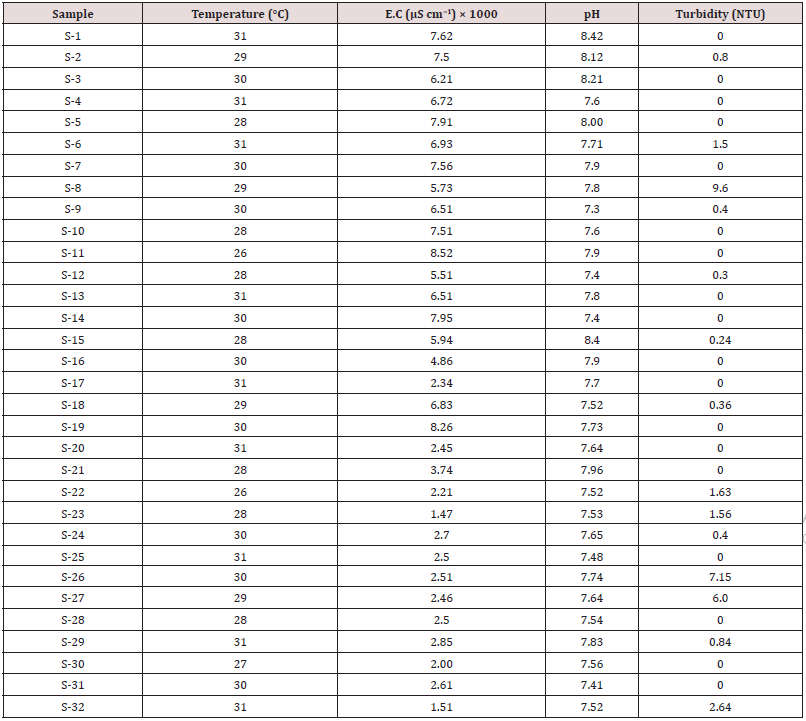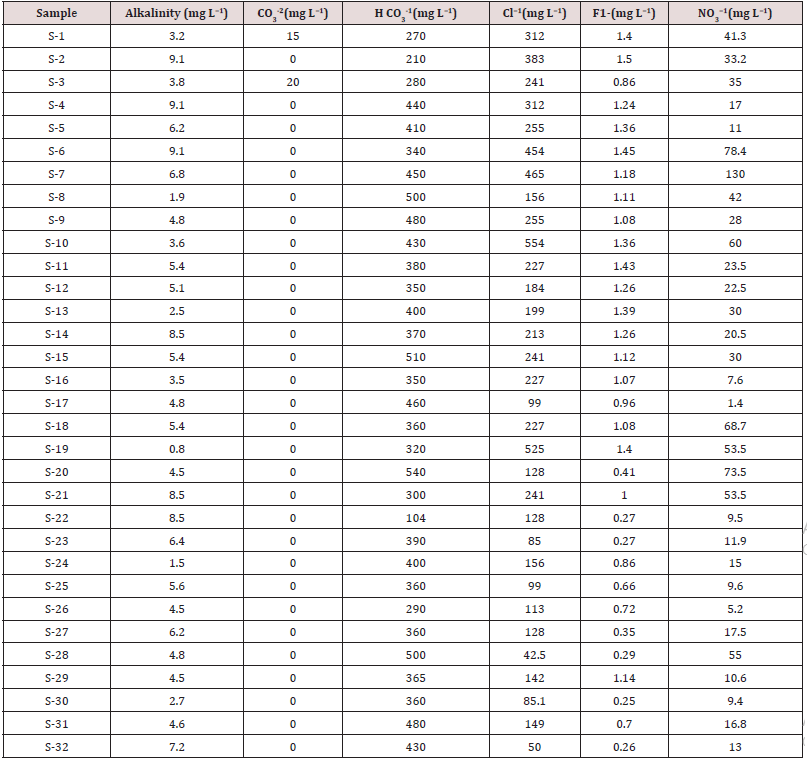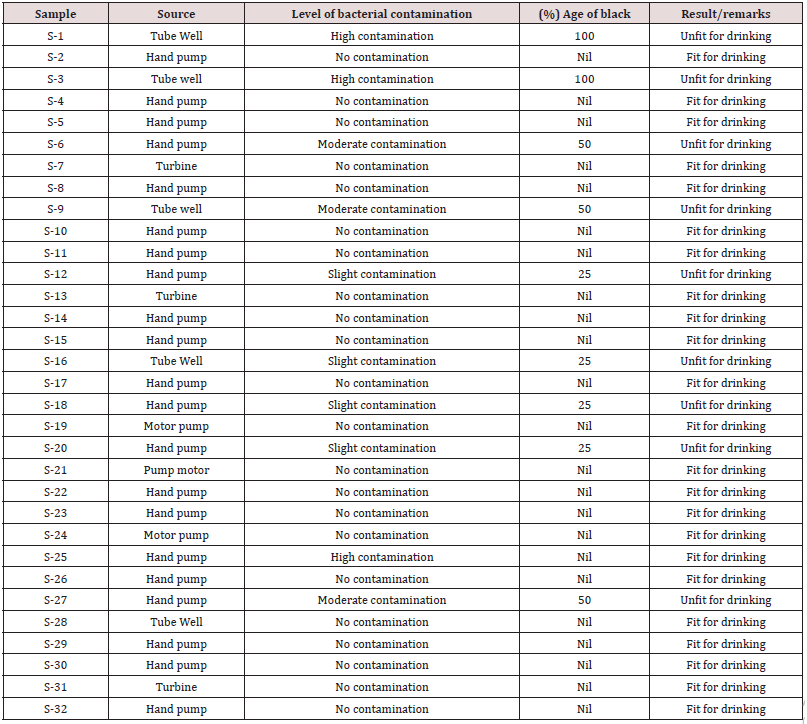
Lupine Publishers Group
Lupine Publishers
Menu
ISSN: 2641-6794
Research Article2641-6794 
Analysis of Fitness of Groundwater for Drinking of Dera Ghazi Khan Volume 3 - Issue 4
Ayaz Ahmad1* and Sahrish Khan2
1Biology Government Degree College, Pakistan
2University of Veterinary & Animal Sciences Lahore, Pakistan
Received:September 05, 2019; Published:September 16, 2019
Corresponding author:Ayaz Ahmad, Biology Government Degree College, Pakistan
DOI: 10.32474/OAJESS.2019.03.000170
Abstract
There were 32 samples of groundwater collected randomly from different sites of Dera Ghazi Khan and were analyzed on physical and chemical basis which shows that quality of groundwater is not good for humans as well as for cattle’s, because it has high values of arsenic, microorganisms, metal ion leaching from the mine wastes and reduction of hydrous ferric oxide. Physical parameters like pH, EC, turbidity and chemical parameters like alkalinity, CO3, HCO3, Cl, F, NO3, and microbial contamination of potential concern for drinking water were estimated by using analytical techniques. During the study it was observed that Electrical conductance (EC) values of groundwater were extremely high from WHO guideline. Likewise, the chemical quality of groundwater samples also goes beyond the WHO guideline values for parameters such as chlorides, sodium, calcium, magnesium and this behaviour of ground water is due to geographical distribution of this area.
Keywords:Groundwater; Physical Parameters; Chemical Parameters; Alkalinity; Dera Ghazi Khan
Introduction
The nature and concentration of salts present in ground water depends upon the source of ground water. This addition of salts is due to weathering of rocks present in area of study [1]. Groundwater, passing through igneous rocks, dissolves very small quantities of mineral matter because of the relative insolubility of the rock composition. Sources of groundwater contamination include saltwater intrusion, landfills, leakage of underground storage and severe agricultural practice [2]. Geographically, Dera Ghazi Khan Pakistan is important in sense due to its central location in the country. The two factors, mountainous area and river are likely to be responsible for changing the chemical behavior of groundwater and making it unfit for drinking with slightly bitter taste. In the study area, groundwater is not only used for drinking, cooking and washing but also people are dependent on groundwater for their agriculture and industry.
Methodology
The methodology reported by [3] was of paramount importance. To find the turbidity of the samples, Nephelometric method by using turbidity meter (Lamotte, model 2008 USA) was adopted and formazin polymer was used as the reference turbidity standard suspension. The sampling bottle was filled up to the mark given on the bottles. After shaking and keeping it at 35 °C for 24–48 h, evaluation was made on the basis of color change in the bottles. Highly bacteriologic contaminated bottles completely turned into black (100% black coloration). Slightly contaminated bottles gave 1/4th or 25% black coloration while bottles with no black color were marked with absolutely free bacteriologic contamination [4].
Sampling
In order to carry out qualitative, quantitative, and semiqualitative microbial analysis, groundwater samples were collected from 32-locations while keeping in view the population and area of Dera Ghazi Khan. Groundwater samples were collected separately in clean, sterilized testing bottles available in the microbiological testing kit for semi-qualitative bacteriological contamination.
Results
Table 1: Statistics of Physical and chemical parameters of groundwater in the area of Dera Ghazi Khan.

Discussion
The quality characteristics of physical parameters in the groundwater of DG Khan-Pakistan are summarized in Table 2, which indicates that electrical conductivity (EC) is extensively high for almost all 32-samples examined. High values of EC are related to enhanced concentration of soluble inorganic salts in groundwater of Dera Ghazi Khan-Pakistan. Apparently, the reason for such high concentration of salts in groundwater is geographical location of study area across the rocky/mountainous region namely Fort Minro in the west. Thus, excessive soluble salts in groundwater of the area may be on the account of dissolution of minerals from local soil and bed rock [4,5]. Nevertheless, few samples with comparatively less EC values are of those sites which are close to Indus River in the east and farther from mountainous area in the west. Of all thirty-two samples, pH is predominantly alkaline and thus is in the satisfactory range i.e. 7.00–8.20 which is in accordance with the prescribed limit of WHO guideline value for pH i.e. 6.5–8.5 (World Health Organization (WHO), 1984). Table 1 shows that turbidity of many samples comes under the WHO recommended guideline i.e. 5-NTU. Bacteria (coli forms) even if in slight contamination make water unfit for drinking purpose and pose permanent threat for several diseases such as diarrhea, typhoid, cholera, dysentery, hepatitis, stomach problem and intestinal disturbances. Out of 32-samples analyzed for microbial contamination, 11 samples gave indication for bacteriological contamination, from highest to slight level, which is mainly result of an open, leaky, unhygienic and unsafe drainage or sewerage system of liquefied solid waste in Dera Ghazi Khan (City)-Pakistan. The results as shown in the Table 3, give an idea about the level or intensity of the microbial contamination in the study area.
Conclusion
Most of the groundwater samples taken from random sites of Dera Ghazi Khan were found unfit for drinking, cooking, washing, bathing and for agricultural aspects. High values of EC, sulfates, chlorides, sodium, magnesium, bicarbonates and bacterial contamination in many water samples were found and thus do not comply with WHO guideline values for these parameters. Nevertheless, parameters like fluoride, potassium, carbonate, alkalinity and arsenic are within the safe limit in many samples of study area.
References
- Abu Rukah, Alsokhny, Abu Rukah Y, Alsokhny K (2003) Geochemistry APHA Standard methods for the examination of water and wastewater (18th edn), American Public Health Association, New York, USA, pp. 171-181
- Braman RS (1975) Arsenical Pesticides American Chemical Society, Washington DC, USA.
- Cassidy DP, DD Werkema, WA Sauck, EA Atekwana, S Rossbach (2001) The Effects of LNAPL Biodegradation Products on Electrical Conductivity Measurements. Journal of Environmental and Engineering Geophysics 6(1): 47-52.
- Chae GT, Yun ST, Kim K, Mayer B (2006) Hydro geochemistry of sodium-bicarbonate type bedrock groundwater in the Pocheon spa area, South Korea. Journal of Hydrology 321(1-4): 326-343.
- E Peters (1984) Evaluation of environmental factors affecting yields of major dissolved ions of streams in the United States. USGS Water-Supply Paper 2228.

Top Editors
-

Mark E Smith
Bio chemistry
University of Texas Medical Branch, USA -

Lawrence A Presley
Department of Criminal Justice
Liberty University, USA -

Thomas W Miller
Department of Psychiatry
University of Kentucky, USA -

Gjumrakch Aliev
Department of Medicine
Gally International Biomedical Research & Consulting LLC, USA -

Christopher Bryant
Department of Urbanisation and Agricultural
Montreal university, USA -

Robert William Frare
Oral & Maxillofacial Pathology
New York University, USA -

Rudolph Modesto Navari
Gastroenterology and Hepatology
University of Alabama, UK -

Andrew Hague
Department of Medicine
Universities of Bradford, UK -

George Gregory Buttigieg
Maltese College of Obstetrics and Gynaecology, Europe -

Chen-Hsiung Yeh
Oncology
Circulogene Theranostics, England -
.png)
Emilio Bucio-Carrillo
Radiation Chemistry
National University of Mexico, USA -
.jpg)
Casey J Grenier
Analytical Chemistry
Wentworth Institute of Technology, USA -
Hany Atalah
Minimally Invasive Surgery
Mercer University school of Medicine, USA -

Abu-Hussein Muhamad
Pediatric Dentistry
University of Athens , Greece

The annual scholar awards from Lupine Publishers honor a selected number Read More...







